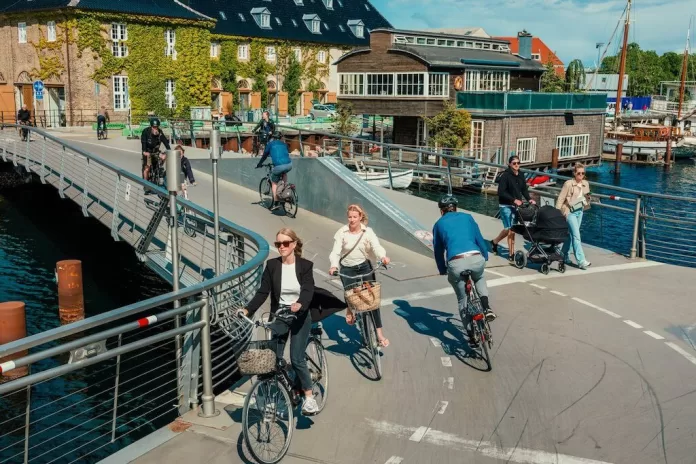In an increasingly urbanized world, the concept of car-free cities is gaining traction as a solution to traffic congestion, pollution, and the loss of community spirit. These unique destinations offer a refreshing escape from the hustle and bustle of modern life, inviting residents and visitors alike to explore their vibrant streets at a leisurely pace.
These cities promote walking, cycling, and public transport, leading to improved air quality, reduced noise pollution, and enhanced community engagement.
Here’s a more detailed look at five car-free cities around the world, showcasing their unique features and modes of transportation:
1. Zermatt, Switzerland
Nestled in the Swiss Alps at the foot of the iconic Matterhorn, Zermatt is renowned for its stunning mountain scenery and car-free environment. The village has been free of cars for decades, allowing only electric vehicles and horse-drawn carriages. Visitors must park their cars in the nearby town of Täsch, approximately 5 kilometers away, and take a shuttle train that runs every 20 minutes into Zermatt. Once in the village, transportation options include walking, biking, and the free eBus service that operates two routes: the skibus and the Winkelmatten bus. The absence of cars creates a peaceful atmosphere, perfect for exploring the charming streets, local shops, and breathtaking hiking trails that surround the area.
2. La Digue, Seychelles
La Digue is a serene paradise in the Seychelles archipelago, famous for its stunning beaches and relaxed pace of life. With no cars allowed, the island encourages visitors to explore by bike, which can be easily rented. The main road loops around the island, making it simple to access highlights like Anse Source d’Argent, celebrated for its pink granite boulders and crystal-clear waters. For those seeking adventure, options include snorkeling, kayaking, and hiking to secluded spots like Anse Coco. A few electric buggies are available for those with limited mobility, ensuring everyone can enjoy the island’s beauty. La Digue embodies the essence of tropical relaxation, free from the hustle and bustle of motorized transport.
3. Venice, Italy
Venice is an architectural marvel built on a network of canals, with the Centro Storico often considered Europe’s largest pedestrian-only area. This unique city is made up of 126 islands connected by over 400 bridges, with transportation primarily facilitated by boats and gondolas. The absence of cars has allowed Venice to preserve its rich history, with stunning medieval buildings and vibrant piazzas. Visitors navigate the narrow alleys and bridges on foot, often experiencing the joy of discovering hidden gems away from the main tourist routes. The city’s love for a car-free lifestyle is so strong that there was even a proposal to ban rolling suitcases to maintain its tranquil ambiance.
4. Lamu, Kenya
Lamu is one of Africa’s oldest continually inhabited towns and is a UNESCO World Heritage Site, known for its rich Swahili culture. Cars are banned in Lamu, creating a peaceful atmosphere that harkens back to centuries past. Transportation relies on donkeys for land travel and dhows for sea travel, connecting the town with the surrounding archipelago. Visitors can wander through narrow streets lined with coral stone buildings, many featuring intricate wooden doors influenced by a blend of Arabic, Persian, and Indian designs. Lamu’s vibrant cultural scene includes traditional festivals, local cuisine, and the famous Lamu Museum, offering a glimpse into its storied past.
5. Fes el Bali, Morocco
Fes el Bali is the larger of the two medinas in Fes and is considered one of the world’s largest car-free areas. Designated a UNESCO World Heritage Site, this medieval city features over 13,000 historic buildings, with streets so narrow that they often restrict access to bicycles. The labyrinthine alleys, bustling souks, and vibrant markets create a unique shopping experience, where visitors can find everything from spices to handmade crafts. The absence of cars preserves the city’s medieval charm and encourages exploration on foot, allowing visitors to soak in the rich history and culture of this fascinating destination. While some areas allow for the use of motor scooters, the narrow paths often make them impractical.
-
Hydra, Greece
Hydra is a charming Greek island that has banned all motorised vehicles since the 1960s. The island’s steep terrain and narrow streets make cars impractical, leading to a reliance on walking, donkeys, and water taxis for transportation. This unique approach has resulted in exceptionally low levels of air pollution. The tranquil atmosphere attracts visitors seeking an eco-friendly destination while allowing residents to enjoy a high quality of life free from vehicular emissions.
READ ALSO: Top 10 Smallest Countries in the World
Benefits of Car-Free Cities
Car-free cities offer numerous advantages that significantly enhance the quality of life for residents and visitors alike. Here are some key benefits:
- Reduced Air Pollution
- The absence of cars leads to lower emissions of harmful pollutants, resulting in cleaner air. This improvement in air quality can have a direct positive impact on public health, reducing respiratory issues and other pollution-related diseases.
- Improved Public Health
- By encouraging walking, cycling, and other forms of non-motorized transport, car-free cities promote physical activity. This helps to reduce obesity rates and lower the prevalence of chronic health issues such as heart disease and diabetes.
- Enhanced Safety
- With fewer vehicles on the roads, the risk of traffic accidents decreases significantly. This creates safer environments for pedestrians and cyclists, leading to more people choosing these modes of transport.
- Sustainable Transportation
- Car-free cities prioritize public transport, biking, and walking, contributing to a more sustainable urban environment. This shift reduces reliance on fossil fuels and lowers greenhouse gas emissions.
- Community Engagement
- These pedestrian-friendly environments foster social interaction. People are more likely to engage with their surroundings and fellow citizens in vibrant public spaces, enhancing community bonds and civic participation.
- Preservation of Cultural Heritage
- Many car-free cities are historically significant. By limiting vehicle access, these areas can protect and maintain their architectural heritage, allowing for a more authentic experience of local culture.
- Economic Opportunities
- Reduced traffic can lead to increased foot traffic in local businesses. This boost in pedestrian activity supports small enterprises and contributes to a thriving local economy.
- Enhanced Urban Design
- Car-free areas often feature more green spaces, parks, and plazas, creating aesthetically pleasing environments. This not only enhances urban living but also contributes to biodiversity and ecological health.
- Reduced Noise Pollution
- With fewer vehicles, noise levels decrease, contributing to a more peaceful urban atmosphere. This tranquility can improve mental well-being for residents and visitors.
- Climate Resilience
- Car-free initiatives can help cities adapt to climate change by reducing greenhouse gas emissions. By promoting sustainable practices, these cities contribute to a more resilient urban ecosystem.
Conclusion
These car-free cities not only provide a tranquil escape from the noise and pollution of modern transportation but also foster a deeper connection to their unique cultures and histories. By promoting walking, biking, and alternative transport methods, these destinations highlight the benefits of a car-free lifestyle, enhancing the quality of life for both residents and visitors.


